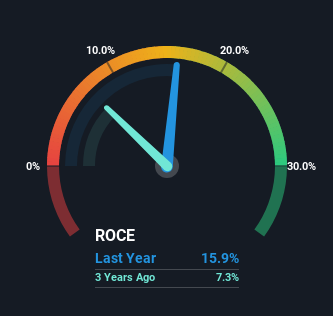- India
- /
- Electrical
- /
- NSEI:HPL
HPL Electric & Power (NSE:HPL) Shareholders Will Want The ROCE Trajectory To Continue

Did you know there are some financial metrics that can provide clues of a potential multi-bagger? Amongst other things, we'll want to see two things; firstly, a growing return on capital employed (ROCE) and secondly, an expansion in the company's amount of capital employed. Ultimately, this demonstrates that it's a business that is reinvesting profits at increasing rates of return. With that in mind, we've noticed some promising trends at HPL Electric & Power (NSE:HPL) so let's look a bit deeper.
Return On Capital Employed (ROCE): What Is It?
If you haven't worked with ROCE before, it measures the 'return' (pre-tax profit) a company generates from capital employed in its business. The formula for this calculation on HPL Electric & Power is:
Return on Capital Employed = Earnings Before Interest and Tax (EBIT) ÷ (Total Assets - Current Liabilities)
0.16 = ₹1.5b ÷ (₹18b - ₹8.7b) (Based on the trailing twelve months to December 2023).
So, HPL Electric & Power has an ROCE of 16%. That's a relatively normal return on capital, and it's around the 18% generated by the Electrical industry.
Check out our latest analysis for HPL Electric & Power

Above you can see how the current ROCE for HPL Electric & Power compares to its prior returns on capital, but there's only so much you can tell from the past. If you'd like to see what analysts are forecasting going forward, you should check out our free analyst report for HPL Electric & Power .
How Are Returns Trending?
The trends we've noticed at HPL Electric & Power are quite reassuring. The data shows that returns on capital have increased substantially over the last five years to 16%. The amount of capital employed has increased too, by 21%. The increasing returns on a growing amount of capital is common amongst multi-baggers and that's why we're impressed.
On a separate but related note, it's important to know that HPL Electric & Power has a current liabilities to total assets ratio of 49%, which we'd consider pretty high. This effectively means that suppliers (or short-term creditors) are funding a large portion of the business, so just be aware that this can introduce some elements of risk. Ideally we'd like to see this reduce as that would mean fewer obligations bearing risks.
In Conclusion...
In summary, it's great to see that HPL Electric & Power can compound returns by consistently reinvesting capital at increasing rates of return, because these are some of the key ingredients of those highly sought after multi-baggers. And a remarkable 407% total return over the last five years tells us that investors are expecting more good things to come in the future. Therefore, we think it would be worth your time to check if these trends are going to continue.
If you'd like to know more about HPL Electric & Power, we've spotted 3 warning signs, and 1 of them is potentially serious.
While HPL Electric & Power may not currently earn the highest returns, we've compiled a list of companies that currently earn more than 25% return on equity. Check out this free list here.
Valuation is complex, but we're here to simplify it.
Discover if HPL Electric & Power might be undervalued or overvalued with our detailed analysis, featuring fair value estimates, potential risks, dividends, insider trades, and its financial condition.
Access Free AnalysisHave feedback on this article? Concerned about the content? Get in touch with us directly. Alternatively, email editorial-team (at) simplywallst.com.
This article by Simply Wall St is general in nature. We provide commentary based on historical data and analyst forecasts only using an unbiased methodology and our articles are not intended to be financial advice. It does not constitute a recommendation to buy or sell any stock, and does not take account of your objectives, or your financial situation. We aim to bring you long-term focused analysis driven by fundamental data. Note that our analysis may not factor in the latest price-sensitive company announcements or qualitative material. Simply Wall St has no position in any stocks mentioned.
About NSEI:HPL
HPL Electric & Power
Manufactures and sells electric equipment under the HPL brand in India.
High growth potential with solid track record.
Market Insights
Community Narratives


